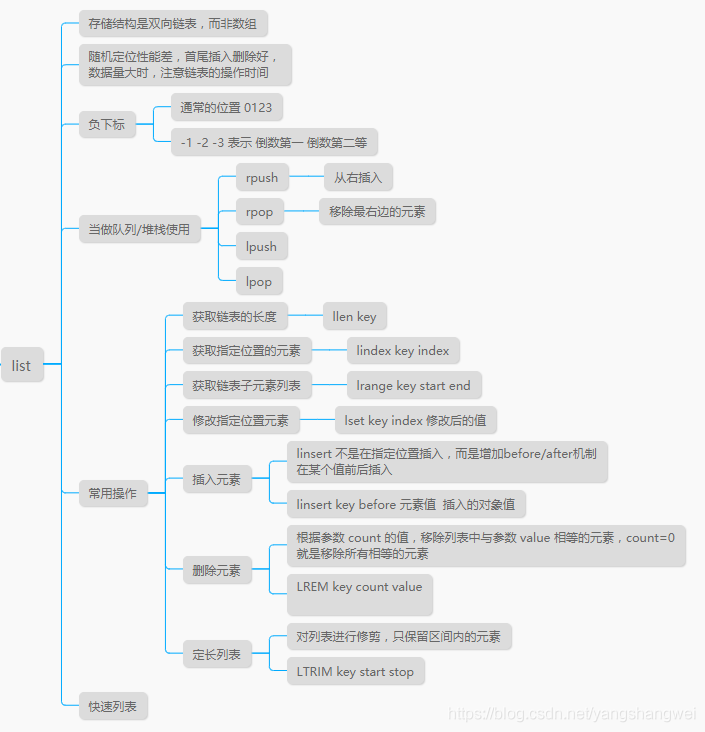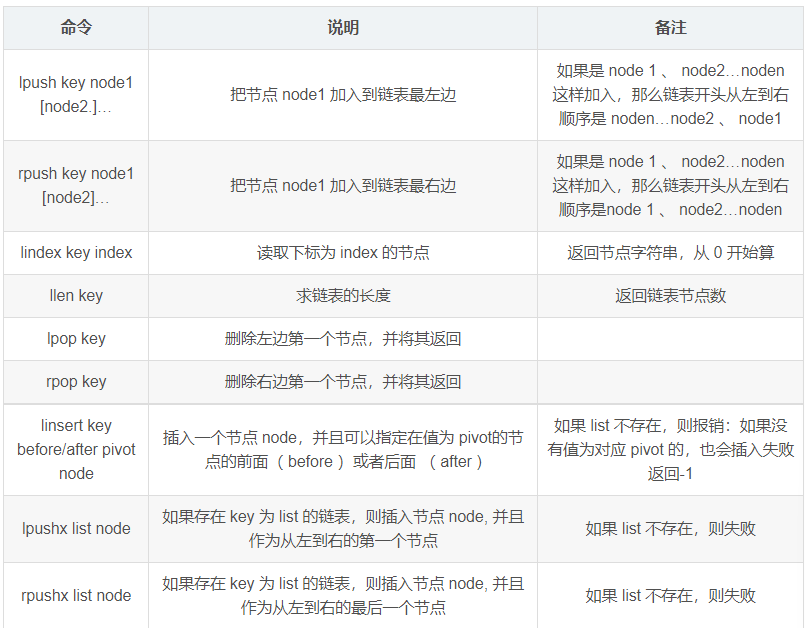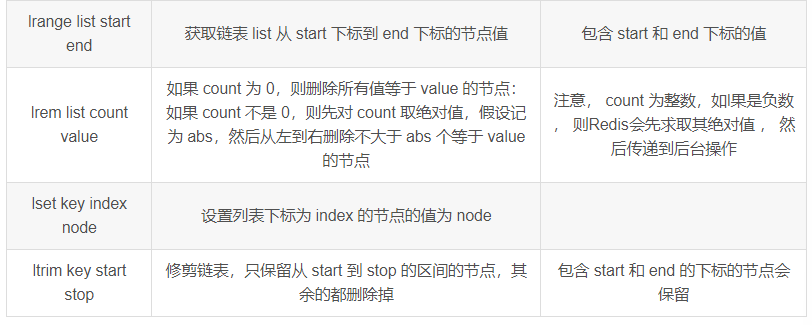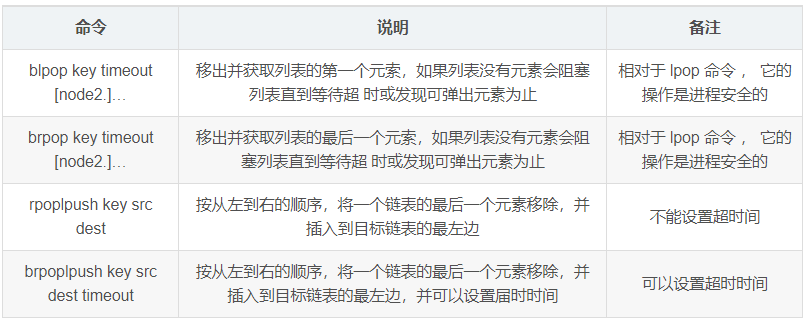概述
链表结构是 Redis 中一个常用的结构,它可以存储多个字符串
它是有序的
能够存储2的32次方减一个节点(超过 40 亿个节点)
Redis 链表是双向的,因此即可以从左到右,也可以从右到左遍历它存储的节点
链表结构查找性能不佳,但 插入和删除速度很快
由于是双向链表,所以只能够从左到右,或者从右到左地访问和操作链表里面的数据节点。 但是使用链表结构就意味着读性能的丧失,所以要在大量数据中找到一个节点的操作性能是不佳的,因为链表只能从一个方向中去遍历所要节点,比如从查找节点 10000 开始查询,它需要按照节点1 、节点 2、节点 3……直至节点 10000,这样的顺序查找,然后把一个个节点和你给出的值比对,才能确定节点所在。如果这个链表很大,如有上百万个节点,可能需要遍历几十万次才能找到所需要的节点,显然查找性能是不佳的。
链表结构的优势在于插入和删除的便利 ,因为链表的数据节点是分配在不同的内存区域的,并不连续,只是根据上一个节点保存下一个节点的顺序来索引而己,无需移动元素。
因为是双向链表结构,所以 Redis 链表命令分为左操作和右操作两种命令,左操作就意味着是从左到右,右操作就意味着是从右到左。
Redis 关于链表的命令
官网 : https://redis.io/commands#list
对于很多个节点同时操作的,需要考虑其花费的时间,链表数据结构对于查找而言并不适合于大数据。我们需要考虑插入和删除内容的大小,因为这将是十分消耗性能的命令,会导致 Redis 服务器的卡顿 。对于不允许卡顿的一些服务器,可以进行分批次操作,以避免出现卡顿。
127.0.0.1:6379> flushdb OK 127.0.0.1:6379> LPUSH list node3 node2 node1 (integer) 3 127.0.0.1:6379> RPUSH list node4 (integer) 4 127.0.0.1:6379> LINDEX list 0 "node1" 127.0.0.1:6379> LLEN list (integer) 4 127.0.0.1:6379> LPOP list "node1" 127.0.0.1:6379> RPOP list "node4" 127.0.0.1:6379> LINSERT list before node2 before_node (integer) 3 127.0.0.1:6379> LINSERT list after node2 after_node (integer) 4 127.0.0.1:6379> LPUSHX list head (integer) 5 127.0.0.1:6379> RPUSHX list end (integer) 6 127.0.0.1:6379> LRANGE list 0 10 1) "head" 2) "before_node" 3) "node2" 4) "after_node" 5) "node3" 6) "end" 127.0.0.1:6379> LPUSH list node node node (integer) 9 127.0.0.1:6379> LREM list 3 node (integer) 3 127.0.0.1:6379> LSET list 0 new_head_value OK 127.0.0.1:6379> LRANGE list 0 10 1) "new_head_value" 2) "before_node" 3) "node2" 4) "after_node" 5) "node3" 6) "end" 127.0.0.1:6379> LTRIM list 0 2 OK 127.0.0.1:6379> LRANGE list 0 10 1) "new_head_value" 2) "before_node" 3) "node2" 127.0.0.1:6379>
使用 Spring 操作 Redis 链表命令
配置文件
<?xml version="1.0" encoding="UTF-8"?> <beans xmlns="http://www.springframework.org/schema/beans" xmlns:xsi="http://www.w3.org/2001/XMLSchema-instance" xmlns:context="http://www.springframework.org/schema/context" xmlns:p="http://www.springframework.org/schema/p" xsi:schemaLocation="http://www.springframework.org/schema/beans http://www.springframework.org/schema/beans/spring-beans.xsd http://www.springframework.org/schema/context http://www.springframework.org/schema/context/spring-context.xsd"> <context:property-placeholder location="classpath:redis/redis.properties" /> <!--2,注意新版本2.3以后,JedisPoolConfig的property name,不是maxActive而是maxTotal,而且没有maxWait属性,建议看一下Jedis源码或百度。 --> <!-- redis连接池配置 --> <bean id="jedisPoolConfig" class="redis.clients.jedis.JedisPoolConfig"> <!--最大空闲数 --> <property name="maxIdle" value="${redis.maxIdle}" /> <!--连接池的最大数据库连接数 --> <property name="maxTotal" value="${redis.maxTotal}" /> <!--最大建立连接等待时间 --> <property name="maxWaitMillis" value="${redis.maxWaitMillis}" /> <!--逐出连接的最小空闲时间 默认1800000毫秒(30分钟) --> <property name="minEvictableIdleTimeMillis" value="${redis.minEvictableIdleTimeMillis}" /> <!--每次逐出检查时 逐出的最大数目 如果为负数就是 : 1/abs(n), 默认3 --> <property name="numTestsPerEvictionRun" value="${redis.numTestsPerEvictionRun}" /> <!--逐出扫描的时间间隔(毫秒) 如果为负数,则不运行逐出线程, 默认-1 --> <property name="timeBetweenEvictionRunsMillis" value="${redis.timeBetweenEvictionRunsMillis}" /> <property name="testOnBorrow" value="true"></property> <property name="testOnReturn" value="true"></property> <property name="testWhileIdle" value="true"></property> </bean> <!--redis连接工厂 --> <bean id="jedisConnectionFactory" class="org.springframework.data.redis.connection.jedis.JedisConnectionFactory" destroy-method="destroy"> <property name="poolConfig" ref="jedisPoolConfig"></property> <!--IP地址 --> <property name="hostName" value="${redis.host.ip}"></property> <!--端口号 --> <property name="port" value="${redis.port}"></property> <!--如果Redis设置有密码 --> <property name="password" value="${redis.password}" /> <!--客户端超时时间单位是毫秒 --> <property name="timeout" value="${redis.timeout}"></property> <property name="usePool" value="true" /> <!--<property name="database" value="0" /> --> </bean> <!-- 键值序列化器设置为String 类型 --> <bean id="stringRedisSerializer" class="org.springframework.data.redis.serializer.StringRedisSerializer"/> <!-- redis template definition --> <bean id="redisTemplate" class="org.springframework.data.redis.core.RedisTemplate" p:connection-factory-ref="jedisConnectionFactory" p:keySerializer-ref="stringRedisSerializer" p:defaultSerializer-ref="stringRedisSerializer" p:valueSerializer-ref="stringRedisSerializer"> </bean> </beans>
package com.artisan.redis.baseStructure.list; import java.io.UnsupportedEncodingException; import java.util.ArrayList; import java.util.List; import org.springframework.context.ApplicationContext; import org.springframework.context.support.ClassPathXmlApplicationContext; import org.springframework.data.redis.connection.RedisListCommands; import org.springframework.data.redis.core.RedisTemplate; public class SpringRedisListDemo { private static String key = "list"; public static void main(String[] args) { ApplicationContext ctx = new ClassPathXmlApplicationContext("classpath:spring/spring-redis-list.xml"); RedisTemplate redisTemplate = (RedisTemplate) ctx.getBean("redisTemplate"); // 不管存不存在,先根据key清理掉链表,方便测试 Boolean flag = redisTemplate.delete(key); System.out.println((flag = true) ? "删除list成功" : "删除list失败"); // 127.0.0.1:6379> LPUSH list node3 node2 node1 // (integer) 3 // 把 node3 插入链表 list System.out.println(redisTemplate.opsForList().leftPush(key, "node3")); // 相当于 lpush 把多个价值从左插入链表 List<String> nodeList = new ArrayList<String>(); for (int i = 2; i >= 1; i--) { nodeList.add("node" + i); } System.out.println(redisTemplate.opsForList().leftPushAll(key, nodeList)); // 127.0.0.1:6379> RPUSH list node4 // (integer) 4 // 从右边插入一个节点 System.out.println(redisTemplate.opsForList().rightPush(key, "node4")); // 127.0.0.1:6379> LINDEX list 0 // "node1" // 获取下标为 0 的节点 String node = (String) redisTemplate.opsForList().index(key, 0); System.out.println("第一个节点:" + node); // 127.0.0.1:6379> LLEN list // (integer) 4 // 获取链表长度 System.out.println(key + "中的总数为:" + redisTemplate.opsForList().size(key)); // 127.0.0.1:6379> LPOP list // "node1" // 从左边弹出 一个节点 String leftPopNode = (String) redisTemplate.opsForList().leftPop(key); System.out.println("leftPopNode:" + leftPopNode); // 127.0.0.1:6379> RPOP list // "node4" // 从右边弹出 一个节点 String rightPopNode = (String) redisTemplate.opsForList().rightPop(key); System.out.println("rightPopNode:" + rightPopNode); // 注意,需要使用更为底层的命令才能操作 linsert 命令 // 127.0.0.1:6379> LINSERT list before node2 before_node // (integer) 3 // 使用 linsert 命令在node2 前插入一个节点 try { Long long1 = redisTemplate.getConnectionFactory().getConnection() .lInsert(key.getBytes("utf-8"), RedisListCommands.Position.BEFORE, "node2".getBytes("utf-8"), "before_node".getBytes("utf-8")); System.out.println(long1); } catch (UnsupportedEncodingException e) { e.printStackTrace(); } // 127.0.0.1:6379> LINSERT list after node2 after_node // (integer) 4 // 使用 linsert 命令在 node2 后插入一个节点 try { Long long2 = redisTemplate.getConnectionFactory().getConnection() .lInsert(key.getBytes("utf-8"), RedisListCommands.Position.AFTER, "node2".getBytes("utf-8"), "after_node".getBytes("utf-8")); System.out.println(long2); } catch (UnsupportedEncodingException e) { e.printStackTrace(); } // 127.0.0.1:6379> LPUSHX list head // (integer) 5 // 判断 list 是否存在,如果存在则从左边插入 head 节点 System.out.println(redisTemplate.opsForList().leftPushIfPresent(key, "head")); // 127.0.0.1:6379> RPUSHX list end // (integer) 6 // 判断 list 是否存在,如果存在则从右边插入 end 节点 System.out.println(redisTemplate.opsForList().rightPushIfPresent(key, "end")); // 127.0.0.1:6379> LRANGE list 0 10 // 1) "head" // 2) "before_node" // 3) "node2" // 4) "after_node" // 5) "node3" // 6) "end" List<String> list = redisTemplate.opsForList().range(key, 0, 10); for (String string : list) { System.out.println("节点:" + string); } // 127.0.0.1:6379> LPUSH list node node node // (integer) 9 // 在链表左边插入三个值为 node 的节点 nodeList.clear(); for (int i = 0; i < 3; i++) { nodeList.add("node"); } System.out.println(redisTemplate.opsForList().leftPushAll(key, nodeList)); // 127.0.0.1:6379> LREM list 3 node // (integer) 3 // 从左到右删除至多三个 node 节点 System.out.println(redisTemplate.opsForList().remove(key, 3, "node")); // 127.0.0.1:6379> LSET list 0 new_head_value // OK // 给链表下标为 0 的节点设置新值 redisTemplate.opsForList().set(key, 0, "new_head_value"); // 127.0.0.1:6379> LRANGE list 0 10 // 1) "new_head_value" // 2) "before_node" // 3) "node2" // 4) "after_node" // 5) "node3" // 6) "end" list = redisTemplate.opsForList().range(key, 0, 10); for (String string : list) { System.out.println("节点:" + string); } // 127.0.0.1:6379> LTRIM list 0 2 // OK redisTemplate.opsForList().trim(key, 0, 2); System.out.println("---------------------"); // 127.0.0.1:6379> LRANGE list 0 10 // 1) "new_head_value" // 2) "before_node" // 3) "node2" list = redisTemplate.opsForList().range(key, 0, 10); for (String string : list) { System.out.println("节点:" + string); } } }
输出结果:
INFO : org.springframework.context.support.ClassPathXmlApplicationContext - Refreshing org.springframework.context.support.ClassPathXmlApplicationContext@73a8dfcc: startup date [Wed Sep 26 10:31:21 CST 2018]; root of context hierarchy INFO : org.springframework.beans.factory.xml.XmlBeanDefinitionReader - Loading XML bean definitions from class path resource [spring/spring-redis-list.xml] 删除list成功 1 3 4 第一个节点:node1 list中的总数为:4 leftPopNode:node1 rightPopNode:node4 3 4 5 6 节点:head 节点:before_node 节点:node2 节点:after_node 节点:node3 节点:end 9 3 节点:new_head_value 节点:before_node 节点:node2 节点:after_node 节点:node3 节点:end --------------------- 节点:new_head_value 节点:before_node 节点:node2
有些命令 Spring 所提供的 RedisTemplate 并不能支持,比如 linsert 命令。可以使用更为底层的方法去操作 ,如下
redisTemplate.getConnectionFactory().getConnection() .lInsert(key.getBytes("utf-8"), RedisListCommands.Position.AFTER, "node2".getBytes("utf-8"), "after_node".getBytes("utf-8"));
在多值操作的时候,往往会使用 list 进行封装 , 比如 leftPushAll 方法,对于很大的 list的操作需要注意性能 , 比如 remove 这样的操作,在大的链表中会消耗 Redis 系统很多的性能。
链表的阻塞命令
上面的这些操作链表的命令都是进程不安全的,因为 当我们操作这些命令的时候,其他 Redis 的客户端也可能操作同一个链表,这样就会造成并发数据安全和一致性的问题,尤其是当你操作一个数据量不小的链表结构时,常常会遇到这样的问题 。 Redis 提供了链表的阻塞命令,它们在运行的时候 , 会给链表加锁,以保证操作链表的命令安全性.
当使用这些命令时, Redis 就会对对应的链表加锁,加锁的结果就是其他的进程不能再读取或者写入该链表,只能等待命令结束 。 加锁的好处可以保证在多线程并发环境中数据的一致性,保证一些重要数据的一致性,比如账户的金额 、 商品的数量。不过在保证这些的同时也要付出其他线程等待、线程环境切换等代价,这将使得系统的并发能力下
127.0.0.1:6379> flushdb OK 127.0.0.1:6379> LPUSH list node1 node2 node3 node4 node5 (integer) 5 127.0.0.1:6379> LRANGE list 0 4 1) "node5" 2) "node4" 3) "node3" 4) "node2" 5) "node1" 127.0.0.1:6379> BLPOP list 2 1) "list" 2) "node5" 127.0.0.1:6379> LRANGE list 0 4 1) "node4" 2) "node3" 3) "node2" 4) "node1" 127.0.0.1:6379> BRPOP list 3 1) "list" 2) "node1" 127.0.0.1:6379> LPUSH list2 data1 data2 data3 (integer) 3 127.0.0.1:6379> RPOPLPUSH list list2 "node2" 127.0.0.1:6379> BRPOPLPUSH list list2 3 "node3" 127.0.0.1:6379> LRANGE list 0 10 1) "node4" 127.0.0.1:6379> LRANGE list2 0 10 1) "node3" 2) "node2" 3) "data3" 4) "data2" 5) "data1"
在实际的项目中 , 虽然阻塞可以有效保证了数据的一致性,但是阻塞就意味着其他进程的等待, CPU 需要给其他线程挂起、恢复等操作,更多的时候我们希望的并不是阻塞的处理请求,所以这些命令在实际中使用得并不多.
使用Spring 操作Redis 链表阻塞命令
package com.artisan.redis.baseStructure.list; import java.util.ArrayList; import java.util.List; import java.util.concurrent.TimeUnit; import org.springframework.context.ApplicationContext; import org.springframework.context.support.ClassPathXmlApplicationContext; import org.springframework.data.redis.core.RedisTemplate; public class SpringRedisBlockListDemo { private static final String KEY1 = "list1"; private static final String KEY2 = "list2"; public static void main(String[] args) { ApplicationContext ctx = new ClassPathXmlApplicationContext("classpath:spring/spring-redis-list.xml"); RedisTemplate redisTemplate = ctx.getBean(RedisTemplate.class); // 清空操作 redisTemplate.delete(KEY1); redisTemplate.delete(KEY2); // 127.0.0.1:6379> LPUSH list node1 node2 node3 node4 node5 // (integer) 5 List<String> list = new ArrayList<String>(); for (int i = 1; i <= 5; i++) { list.add("node" + i); } redisTemplate.opsForList().leftPushAll(KEY1, list); scanList(redisTemplate, KEY1, 0, 4); System.out.println("---------------------------"); // 127.0.0.1:6379> BLPOP list 2 // 1) "list" // 2) "node5" // Spring 使用参数超时时间作为阻塞命令区分,等价于 blpop 命令,并且可以设置时间参数 String lefpPodNode = (String) redisTemplate.opsForList().leftPop(KEY1, 2, TimeUnit.SECONDS); System.out.println("leftPopNode:" + lefpPodNode); System.out.println("---------------------------"); // 127.0.0.1:6379> LRANGE list 0 4 // 1) "node4" // 2) "node3" // 3) "node2" // 4) "node1" scanList(redisTemplate, KEY1, 0, 4); System.out.println("---------------------------"); // 127.0.0.1:6379> BRPOP list 3 // 1) "list" // 2) "node1" // Spring 使用参数超时时间作为阻塞命令区分,等价于 brpop 命令,并且可以设置时间参数 System.out.println("rightPopNode:" + redisTemplate.opsForList().rightPop(KEY1, 3, TimeUnit.SECONDS)); System.out.println("---------------------------"); // 127.0.0.1:6379> LRANGE list 0 4 // 1) "node4" // 2) "node3" // 3) "node2" scanList(redisTemplate, KEY1, 0, 4); System.out.println("---------------------------"); // 127.0.0.1:6379> LPUSH list2 data1 data2 data3 // (integer) 3 List<String> list2 = new ArrayList<String>(); for (int i = 3; i >= 1; i--) { list2.add("data" + i); } System.out.println(redisTemplate.opsForList().leftPushAll(KEY2, list2)); System.out.println("---------------------------"); // 127.0.0.1:6379> RPOPLPUSH list list2 // "node2" // 相当于 rpoplpush 命令,弹出 list1最右边的节点,插入到 list2 最左边 String value2 = (String) redisTemplate.opsForList().rightPopAndLeftPush(KEY1, KEY2); System.out.println("rightPopAndLeftPush:" + value2); System.out.println("-------------------"); // 127.0.0.1:6379> BRPOPLPUSH list list2 3 // "node3" // 相当于 brpoplpush 命令,注意在 Spring 中使用超时参数区分 String value3 = (String) redisTemplate.opsForList().rightPopAndLeftPush(KEY1, KEY2, 3, TimeUnit.SECONDS); System.out.println("rightPopAndLeftPush:" + value3); System.out.println("-------------------"); // 127.0.0.1:6379> LRANGE list 0 10 // 1) "node4" scanList(redisTemplate, KEY1, 0, 10); System.out.println("-------------------"); // 127.0.0.1:6379> LRANGE list2 0 10 // 1) "node3" // 2) "node2" // 3) "data3" // 4) "data2" // 5) "data1" scanList(redisTemplate, KEY2, 0, 10); } private static void scanList(RedisTemplate redisTemplate, String key, int begin, int end) { List<String> data = redisTemplate.opsForList().range(key, begin, end); for (String string : data) { System.out.println("节点:" + string); } } }
输出
INFO : org.springframework.context.support.ClassPathXmlApplicationContext - Refreshing org.springframework.context.support.ClassPathXmlApplicationContext@73a8dfcc: startup date [Wed Sep 26 12:53:56 CST 2018]; root of context hierarchy INFO : org.springframework.beans.factory.xml.XmlBeanDefinitionReader - Loading XML bean definitions from class path resource [spring/spring-redis-list.xml] 节点:node5 节点:node4 节点:node3 节点:node2 节点:node1 --------------------------- leftPopNode:node5 --------------------------- 节点:node4 节点:node3 节点:node2 节点:node1 --------------------------- rightPopNode:node1 --------------------------- 节点:node4 节点:node3 节点:node2 --------------------------- 3 --------------------------- rightPopAndLeftPush:node2 ------------------- rightPopAndLeftPush:node3 ------------------- 节点:node4 ------------------- 节点:node3 节点:node2 节点:data1 节点:data2 节点:data3
上面展示了 Redis 关于链表的阻塞命令,在 Spring 中它和非阻塞命令的方法是一致的,只是它会通过超时参数进行区分,而且我们还可以通过方法设置时间的单位。 注意,它是阻塞的命令,在多线程的环境中,它能在一定程度上保证数据 的一致而性能却不佳。
注意
使用 Spring 提供的 RedisTemplate 去展示多个命令可以学习到如何使用 RedisTemplate 操作 Redis 。 实际工作中并不是那么用的,因为每一 个操作会尝试从连接池里获取 一 个新的 Redis 连接,多个命令应该使用SessionCallback 接口进行操作 。



